2023 Anchorage Municipality, Alaska Demographics | Data & Analysis
Ready-to-use reports, analytics, and visualizations covering Anchorage Municipality, Alaska, including population, race, income, and more. Based on 2023 American Community Survey Estimates.
Anchorage Municipality, Alaska Key Demographic Statistics (2023 Estimates)
Key demographic statistics summarized from the U.S. Census Bureau's 2023 American Community Survey (ACS).
Source: U.S. Census Bureau, 2023 American Community Survey (ACS) Estimates
Anchorage Municipality, Alaska Demographics: Age & Gender Distribution (2023)
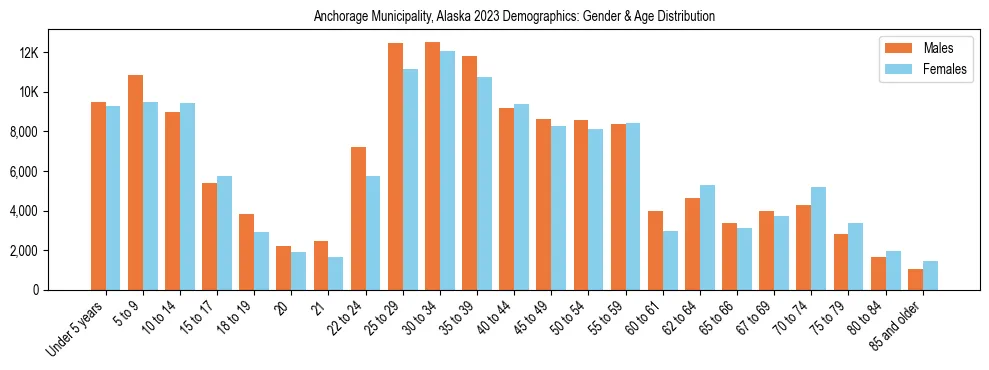
Key Demographic Indicators for Anchorage Municipality, Alaska
The following statistics highlight Anchorage Municipality, Alaska population and median age, based on U.S. Census Bureau 2023 ACS Estimates.
- Total Population
- 289,069
- Median Age (Total)
- 34.9 years
- Median Age (Male)
- 34.2 years
- Median Age (Female)
- 35.7 years
Anchorage Municipality, Alaska Population Age Distribution 2023
| Age Cohort | Share of Population |
|---|---|
| Under 5 years | 6.50% |
| 5–17 years (Children) | 17.25% |
| 18–24 years (Young Adults) | 9.66% |
| 25–34 years | 16.68% |
| 35–54 years | 25.83% |
| 55–64 years | 11.65% |
| 65 years and over (Seniors) | 12.43% |
Dependency Ratios Analysis
- Total Dependency Ratio
- 56.69
- Youth Dependency Ratio
- 37.22 Population under 18 relative to working age (18-64).
- Old-Age Dependency Ratio
- 19.48 Population 65+ relative to working age (18-64).
A higher ratio indicates a greater financial and social burden on the working population to support non-working age groups.
What is the Racial and Ethnic Breakdown of Anchorage Municipality, Alaska (2023)?

Diversity & Cultural Composition of Anchorage Municipality, Alaska
The racial makeup and ethnic composition of Anchorage Municipality, Alaska are detailed below, drawing from the U.S. Census Bureau's 2023 ACS Estimates.
- Diversity Index Score
- 65.99
- Diversity Tier
- high
- Definition
- The probability that two individuals chosen at random from Anchorage Municipality, Alaska will be from different racial or ethnic groups.
Anchorage Municipality, Alaska Population by Race/Ethnicity
| Racial/Ethnic Group | Percentage |
|---|---|
| White Alone (Non-Hispanic) | 55.09% |
| Two or More Races | 10.00% |
| Asian Alone | 9.67% |
| Hispanic or Latino (Any Race) | 9.32% |
| American Indian and Alaska Native Alone | 7.00% |
| Black/African American Alone | 5.07% |
| Native Hawaiian or Other Pacific Islander Alone | 3.06% |
| Some Other Race Alone | 0.78% |
Anchorage Municipality, Alaska Economic Demographics: Household Income Statistics (2023)

Economic Snapshot for Anchorage Municipality, Alaska
The following data illustrates the financial landscape of Anchorage Municipality, Alaska, based on the latest U.S. Census Bureau 2023 ACS Estimates.
- Median Household Income
- $98,152 (Adjusted for inflation)
- Total Households Analyzed
- 107,868
Anchorage Municipality, Alaska Household Income Distribution by Income Brackets
| Annual Income Range | Share of Households |
|---|---|
| Less than $20,000 | 7.84% |
| $20,000 to $34,999 | 6.32% |
| $35,000 to $49,999 | 8.32% |
| $50,000 to $74,999 | 14.61% |
| $75,000 to $149,999 | 33.23% |
| $150,000 or more | 29.69% |
Anchorage Municipality, Alaska Real Estate Demographics: Property Values (2023)

Real Estate Market Snapshot for Anchorage Municipality, Alaska
The following data highlights the distribution of owner-occupied housing values in Anchorage Municipality, Alaska, based on the latest U.S. Census Bureau 2023 ACS Estimates.
- Median Property Value
- $375,900
- Total Properties Analyzed
- 68,751 (Owner-occupied units)
Anchorage Municipality, Alaska Property Value Brackets
| Value Range | Share of Properties |
|---|---|
| Less than $25,000 | 1.90% |
| $25,000 to $49,999 | 2.20% |
| $50,000 to $99,999 | 1.17% |
| $100,000 to $199,999 | 7.43% |
| $200,000 to $499,999 | 63.26% |
| $500,000 to $999,999 | 23.52% |
| $1,000,000 or more | 0.53% |
Anchorage Municipality, Alaska Educational Attainment Statistics (2023)
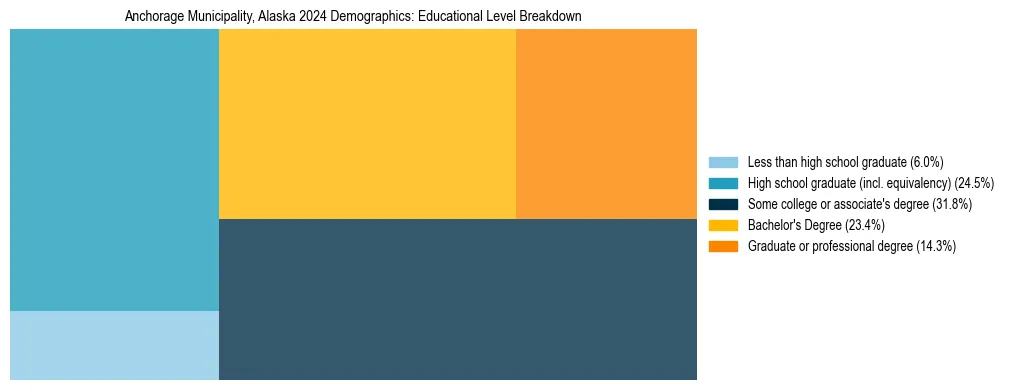
Education Snapshot for Anchorage Municipality, Alaska
The following statistics represent the educational background of residents aged 25 and older in Anchorage Municipality, Alaska, based on U.S. Census Bureau 2023 ACS Estimates.
- High School Graduate or Higher
- 94.01%
- Bachelor's Degree or Higher
- 37.68%
- Total Population Analyzed (25+)
- 192,495
Anchorage Municipality, Alaska Education Levels
| Education Level | Share of Population (25+) |
|---|---|
| Less than high school graduate | 5.99% |
| High school graduate (incl. equivalency) | 24.49% |
| Some college or associate's degree | 31.84% |
| Bachelor's Degree | 23.39% |
| Graduate or professional degree | 14.29% |
Anchorage Municipality, Alaska Health Insurance Coverage Statistics (2023)

Healthcare Coverage Snapshot for Anchorage Municipality, Alaska
The following data illustrates the health coverage landscape of Anchorage Municipality, Alaska, based on U.S. Census Bureau 2023 ACS Estimates.
- Overall Uninsured Rate
- 10.0%
- Total Uninsured Population
- 27,758
- Total Civilian Population
- 276,514
The uninsured rates vary significantly by demographic group. Children under 18 and seniors aged 65+ generally have higher coverage rates due to public programs like Medicaid/CHIP and Medicare.
Anchorage Municipality, Alaska Uninsured Rates by Demographics
| Age Group | Male Uninsured % | Female Uninsured % |
|---|---|---|
| Under 18 | 7.7% | 7.1% |
| 18-34 years | 22.3% | 14.5% |
| 35-64 years | 10.5% | 9.0% |
| 65+ years | 1.2% | 1.1% |
Anchorage Municipality, Alaska Nativity & Citizenship Statistics (2023)
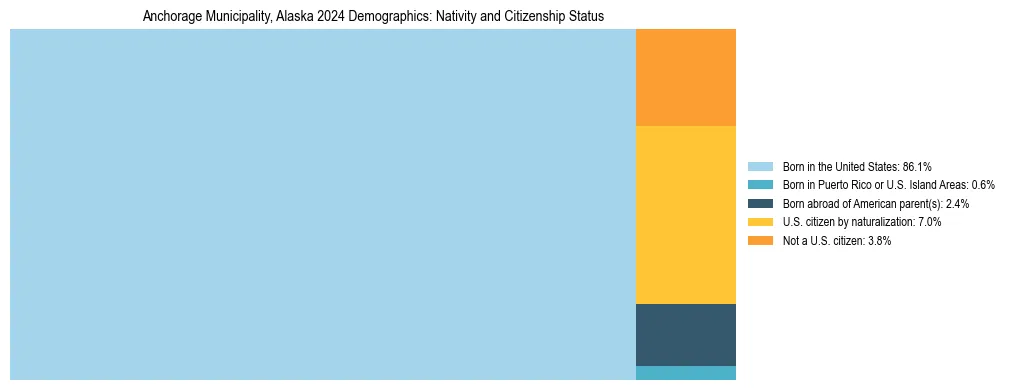
Citizenship Snapshot for Anchorage Municipality, Alaska
The following data details the citizenship status and nativity of the population in Anchorage Municipality, Alaska, based on U.S. Census Bureau 2023 ACS Estimates.
- U.S. Citizenship Rate
- 96.2% (Native-born + Naturalized)
- Naturalized Citizens
- 20,362 (Foreign-born individuals who acquired citizenship)
- Non-Citizen Residents
- 11,037
Anchorage Municipality, Alaska Nativity Breakdown
| Nativity/Citizenship Status | Percentage |
|---|---|
| Born in the United States | 86.1% |
| Born in Puerto Rico or U.S. Island Areas | 0.6% |
| Born abroad of American parent(s) | 2.4% |
| U.S. citizen by naturalization | 7.0% |
| Not a U.S. citizen | 3.8% |
| Total U.S. Citizens | 96.2% |
Anchorage Municipality, Alaska Commuting & Transportation Statistics (2023)
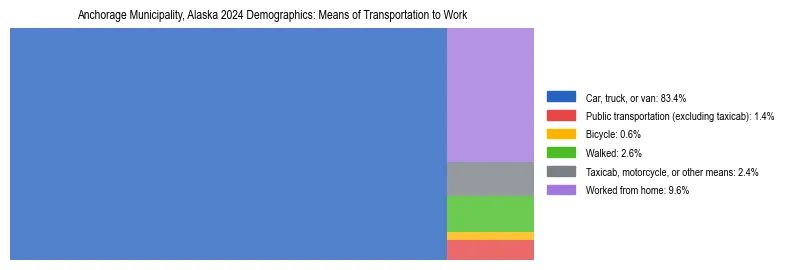
Commuter Snapshot for Anchorage Municipality, Alaska
The following data details the commuting habits of the workforce in Anchorage Municipality, Alaska, based on U.S. Census Bureau 2023 ACS Estimates.
- Drove to Work (Car/Truck/Van)
- 83.4%
- Public Transportation Usage
- 1.4%
- Work From Home Rate
- 9.6%
- Total Workers Analyzed
- 148,502
Anchorage Municipality, Alaska Commute Breakdown
| Transportation Method | Percentage | Number of Workers |
|---|---|---|
| Car, truck, or van | 83.4% | 123,836 |
| Public transportation | 1.4% | 2,093 |
| Bicycle | 0.6% | 903 |
| Walked | 2.6% | 3,815 |
| Taxicab, motorcycle, or other means | 2.4% | 3,600 |
| Worked from home | 9.6% | 14,255 |
| Total Workers | - | 148,502 |
Anchorage Municipality, Alaska Employment by Class of Worker (2023)
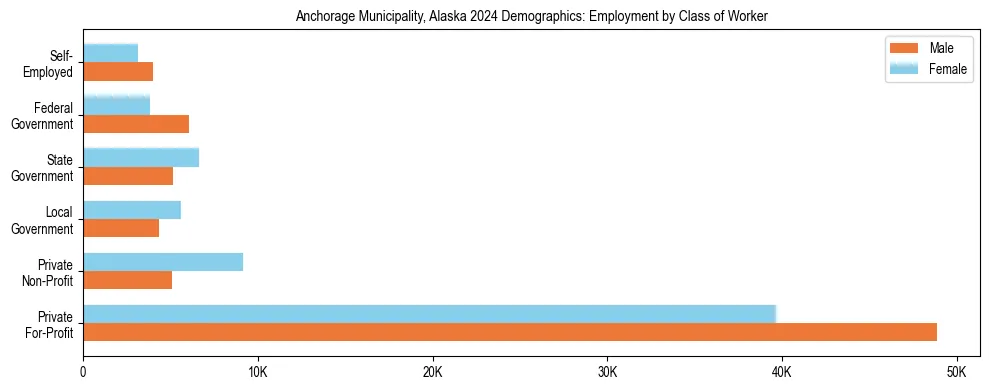
Workforce Snapshot for Anchorage Municipality, Alaska
The following statistics categorize the civilian employed population aged 16 and over in Anchorage Municipality, Alaska by their employment sector, based on U.S. Census Bureau 2023 ACS Estimates.
- Total Employed Civilian Population
- 141,941
- Private Sector (Profit & Non-Profit)
- Includes For-Profit and Non-Profit organizations
- Government Workers
- Includes Local, State, and Federal employees
- Self-Employed Workers
- Includes own not incorporated business workers
Anchorage Municipality, Alaska Employment Sector Breakdown
| Employment Class | Male Workers | Female Workers |
|---|---|---|
| Private For-Profit | 48,862 (34.4%) | 39,662 (27.9%) |
| Private Non-Profit | 5,122 (3.6%) | 9,159 (6.5%) |
| Government (All Levels) | 15,565 (11.0%) | 16,102 (11.3%) |
| • Local Government | 4,330 | 5,623 |
| • State Government | 5,175 | 6,660 |
| • Federal Government | 6,060 | 3,819 |
| Self-Employed | 4,038 (2.8%) | 3,151 (2.2%) |
Definitions: "Private sector" includes employees of for-profit and non-profit companies. "Government" includes all local, state, and federal employees. "Self-employed" refers to those operating their own unincorporated businesses.
Anchorage Municipality, Alaska Veteran Population & Service Statistics (2023)
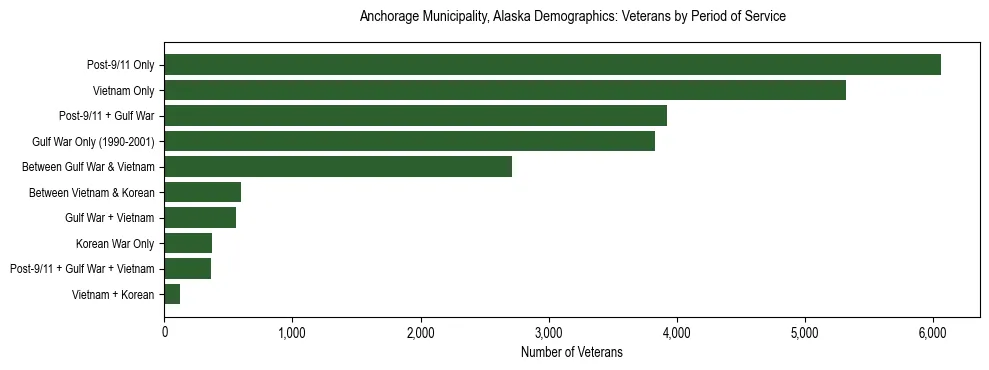
Veteran Community Snapshot for Anchorage Municipality, Alaska
The following data details the civilian veteran population aged 18 and over in Anchorage Municipality, Alaska, based on U.S. Census Bureau 2023 ACS Estimates.
- Total Civilian Veterans
- 23,940
- Primary Service Era
- Post-9/11 Only
6,062 veterans (25.3%)
Anchorage Municipality, Alaska Service Period Breakdown
| Period of Service | Number of Veterans | Percentage |
|---|---|---|
| Post-9/11 Only (September 2001 or later) | 6,062 | 25.3% |
| Vietnam Era Only (August 1964 to April 1975) | 5,321 | 22.2% |
| Post-9/11 and Gulf War (August 1990 to August 2001) | 3,924 | 16.4% |
| Gulf War Only (August 1990 to August 2001) | 3,830 | 16.0% |
| Between Gulf War and Vietnam Era | 2,716 | 11.3% |
| Between Vietnam Era and Korean War | 597 | 2.5% |
| Gulf War and Vietnam Era | 562 | 2.3% |
| Korean War Only (July 1950 to January 1955) | 372 | 1.6% |
| Post-9/11, Gulf War, and Vietnam Era | 368 | 1.5% |
| Vietnam Era and Korean War | 125 | 0.5% |
| World War II Only (December 1941 to December 1946) | 62 | 0.3% |
| Between Korean War and World War II | 1 | 0.0% |
| Total Veterans | 23,940 | 100.0% |
Note: Periods of service include World War II (Dec 1941–Dec 1946), Korean War (Jul 1950–Jan 1955), Vietnam Era (Aug 1964–Apr 1975), Gulf War (Aug 1990–Aug 2001), and Post-9/11 (Sept 2001 or later). Veterans may have served in multiple eras.
Anchorage Municipality, Alaska Family Poverty & Income Statistics (2023)

Family Economic Security Snapshot for Anchorage Municipality, Alaska
The following data categorizes families in Anchorage Municipality, Alaska by their income relative to the federal poverty threshold, based on U.S. Census Bureau 2023 ACS Estimates.
- Families Below Poverty Line (<100%)
- 5.8% (3,906 families)
- Families Near Poverty (100-199%)
- 23.0% (15,572 families)
- Families with Secure Income (200%+)
- 71.3% (48,272 families)
Anchorage Municipality, Alaska Income-to-Poverty Ratio Breakdown
| Income-to-Poverty Ratio Category | Number of Families | Percentage |
|---|---|---|
| Below 50% of Poverty | 1,728 | 2.6% |
| 50-74% of Poverty | 1,016 | 1.5% |
| 75-99% of Poverty | 1,162 | 1.7% |
| 100-124% of Poverty | 1,587 | 2.3% |
| 125-149% of Poverty | 1,453 | 2.1% |
| 150-174% of Poverty | 2,254 | 3.3% |
| 175-184% of Poverty | 555 | 0.8% |
| 185-199% of Poverty | 1,192 | 1.8% |
| 200-299% of Poverty | 8,531 | 12.6% |
| 300-399% of Poverty | 8,296 | 12.2% |
| 400-499% of Poverty | 7,860 | 11.6% |
| 500%+ of Poverty | 32,116 | 47.4% |
| Total Families | 67,750 | 100.0% |
Definition: The "Income-to-Poverty Ratio" measures a family's income against the federal poverty threshold. A ratio below 1.00 means the family is in poverty. Ratios between 1.00 and 1.99 indicate low income ("near poverty"), while ratios of 2.00 or higher suggest greater economic security.
Anchorage Municipality, Alaska SNAP/Food Stamps Statistics (2023)
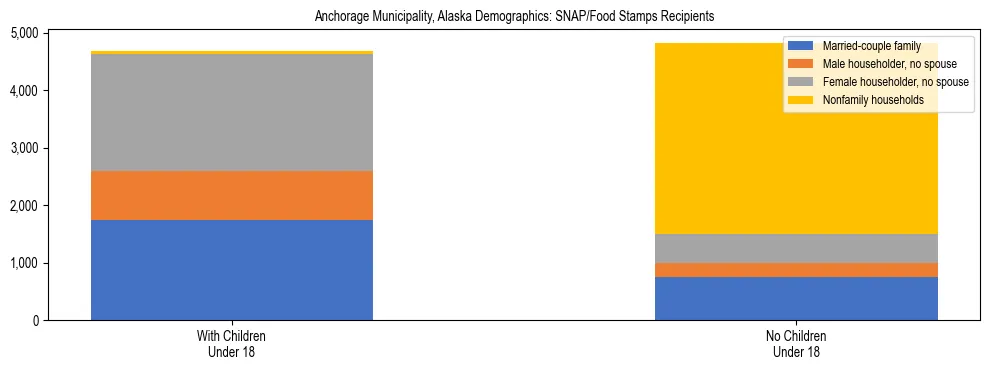
SNAP Participation Snapshot for Anchorage Municipality, Alaska
The following data details household participation in the Supplemental Nutrition Assistance Program (SNAP) in Anchorage Municipality, Alaska, based on U.S. Census Bureau 2023 ACS Estimates.
- Total Households Receiving SNAP
- 9,497 (8.80% of all households)
- Recipient Households with Children
- 4,679 (49.27% of recipients)
- Total Households Analyzed
- 107,868
Anchorage Municipality, Alaska SNAP Recipient Demographics
| Household Type | With Children Under 18 | No Children Under 18 |
|---|---|---|
| Married-Couple Family | 1,733 (18.25%) | 753 (7.93%) |
| Male Householder, No Spouse | 859 (9.04%) | 233 (2.45%) |
| Female Householder, No Spouse | 2,035 (21.43%) | 518 (5.45%) |
| Nonfamily Households | 52 (0.55%) | 3,314 (34.90%) |
About this data: The Supplemental Nutrition Assistance Program (SNAP) provides food assistance to low-income families. Households with children often face higher participation rates due to eligibility guidelines prioritizing child nutrition. "Nonfamily households" typically refer to individuals living alone or with unrelated roommates.